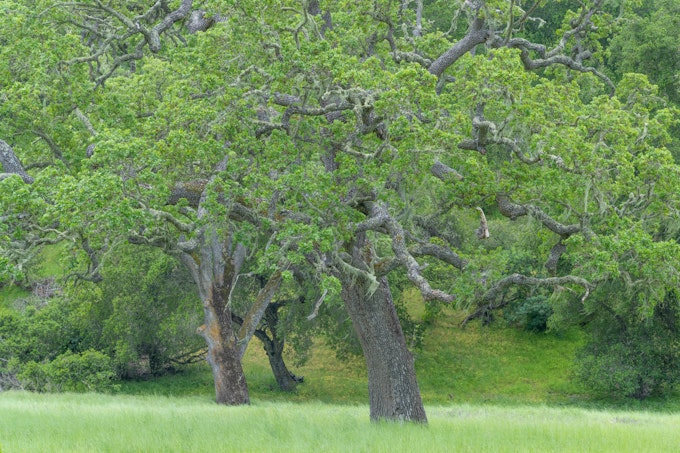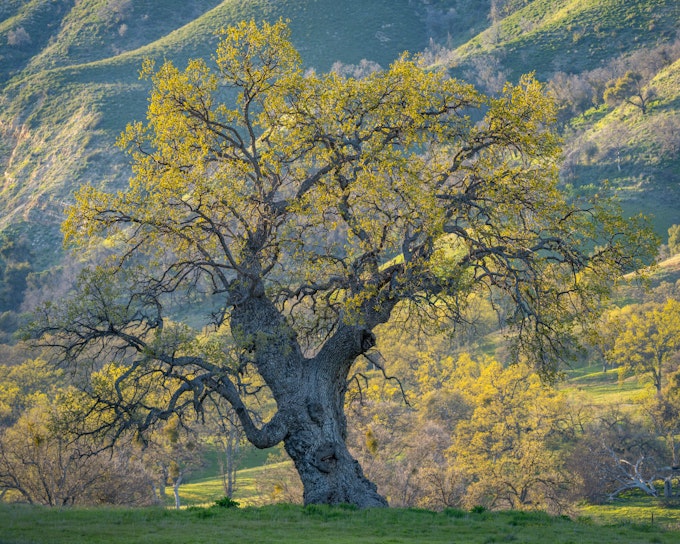Exploring the San Antonio Valley: The other side of Big Sur
Exploring the San Antonio Valley, The Valley of the Oaks is to explore pre-history, history, and a most beautiful landscape filled with surprises big and small.

Native American village sites, ancient pictographs, a Spanish Mission, a river, creeks, mountains to walk up, great old-growth oaks, miles of savannah, old mines...and more. For people familiar with the western Big Sur and the coast, the eastern slopes of the Santa Lucia Range are a wonderful alternative.
The San Antonio River flows from out of the Santa Lucia Mountain Range, shaping a fertile landscape over millennia as it journeys toward the Salinas River. This river has witnessed the valley's evolution—from the rich oak savannahs, adorned each spring with a radiant showcase of wildflowers, to the distinct chapters of human history etched into the landscape.
What to do:
There are many trails to explore along creeks, up canyons, and up further to nearby mountain peaks, Junipero Serra Peak, and Cone Peak. The headwaters of the Arroyo Secco River are also accessed and the riparian landscapes along these waterways are wonderful in all seasons though late winter, spring, and early summer are prime. Fall comes late to the valley and the changing of the colors is worth a visit through January.

So many different kinds of explorers will love this place. Whether you love birds, wildlife, hunting, or spring flowers, it’s all here in abundance. Wide open spaces, canyons, and rocks to climb over, it's fun.
A particularly interesting location is Big Rock. A large outcropping of rock, that is quite fun to scramble onto, is covered with evidence of Indian habitation. Almost every rock alcove, there are many, contains soot from fires. Mortar holes are found in abundance. Some petroglyphs too can be found. The view from the top of Big Rock allows for a visual survey of the valley, oaks, savannah, river, and creeks. It’s beautiful.

A journey down the roads of the San Antonio Valley takes you through an ancient oak woodland where blue oaks and valley oaks, some centuries old, stretch their sprawling canopies over gentle hills and open plains. The forest of oaks with limbs cloaked in hanging lichens, extends across vast grasslands with a sparse understory, showcasing a prime representation of the Santa Lucia Range’s oak woodlands.
While the grand blue oak and valley oak stand as the principal tree species in this region, you'll also encounter other oak varieties such as the coast live oak, interior live oak, canyon live oak, and California black oak sprinkled throughout the landscape.
See more photos of Big Sur's trees here.
The forest floor is covered in a tranquil understory of grasses and herbaceous plants. Among these, you find poison oak, toyon, California coffeeberry, creeping snowberry, and saplings of oak.
The heritage oaks in this valley are each their own destination. Some are hundreds of years old. Each with a character of its own. Driving through the valley in the early morning or evening is a treat when soft light filters through the canopies and the grasses.
The Junípero Serra trail is also worth the effort to gain the peak. The creeks crossed ascending the trail are each their own worlds of beauty. Even as the landscape recovered from the Dolan Fire of 2020, the flora is growing and thriving.
Wildlife is diverse and evident. Deer, mountain lion, bobcat, eagles, condors, turkey vultures, rabbits, birds and their song, wild boar, rattlesnakes, and lizards, (the horny toad is fascinating and intense) all make for nuanced visits.
The pre-history and history of the San Antonio Valley
The valley has long been a home—a home first to the Salinan people over 10,000 years ago, with their cherished traditions and respectful harvest from the bounty around them. Change arrived with the Portola expedition of 1769, under the Spanish flag, altering the lives of the Salinan people profoundly. Transitioned to agricultural and artisanal ways of life within the precincts of the mission, they experienced a cultural metamorphosis.
Mission San Antonio de Padua, founded in the year 1771, changed the nature of life in the area drastically. Christianization, infectious disease, irrigation, force, and coercion, all brought an end to a way of living off the land. With the decline of the Spanish empire, the Mission system gave way to rancheros then homesteaders, and now a mix of federal, state, and private ownership.
William Randolf Hearst bought much of the land in the area for his own private hunting ranch. He built a Hacienda, imagined by architect Julia Morgan, which is now a motel where the public can stay on the grounds of Fort Hunter Ligget.
John Steinbeck's first novel "To a God Unknown," unfolds within the San Antonio Valley, or the Valley of Our Lady as it's known in the tale. Through the character of Joseph Wayne Steinbeck explores the landscape and the challenge of drought. Steinbeck weaves a narrative rich in cultural tapestry, melding the histories of Native American, Spanish, Mexican, and Anglo settlers; the pastoral pursuits of cattle ranching; and the relentless forces of nature. It’s a mysterious novel, one that captures elements of the experience of exploring the Santa Lucia Range and the Big Sur coast.
Steinbeck described the valley perfectly:
AFTER a time of wandering, Joseph came to the long valley called Nuestra Señora, and there he recorded his homestead. Nuestra Señora, the long valley of Our Lady in central California, was green and gold and yellow and blue when Joseph came into it The level floor was deep in wild oats and canary mustard flowers. The river San Francisquito flowed noisily in its bouldered bed through a cave made by its little narrow forest. Two flanks of the coast range held the valley of Nuestra Señora close, on one side guarding it against the sea, and on the other against the blasting winds of the great Salinas Valley. At the far southern end a pass opened in the hills to let out the river, and near this pass lay the church and the little town of Our Lady. The huts of Indians clustered about the mud walls of the church, and although the church was often vacant now and its saints were worn and part of its tile roof lay in a shattered heap on the ground, and although the bells were broken, the Mexican Indians still lived near about and held their festivals, danced La Jota on the packed earth and slept in the sun.The San Antonio Valley isn't just a backdrop to a story—it is the story, a natural sanctuary to an array of wildlife and a rich blend of histories.
We want to acknowledge and thank the past, present, and future generations of all Native Nations and Indigenous Peoples whose ancestral lands we travel, explore, and play on. Always practice Leave No Trace ethics on your adventures and follow local regulations. Please explore responsibly!
Do you love the outdoors?
Yep, us too. That's why we send you the best local adventures, stories, and expert advice, right to your inbox.







